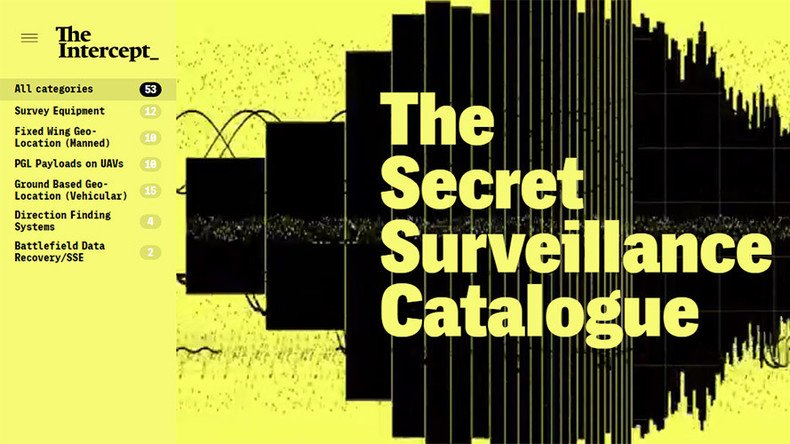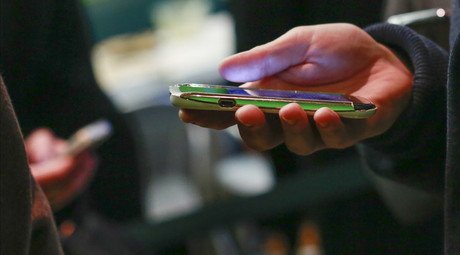Intercepted catalog shows off secret surveillance gear

A secret catalog of surveillance gear has been leaked by a concerned US intelligence official. The document reveals details about devices that can intercept, collect and read civilian communications, such as the ‘dirtboxes’ or the notorious ‘Stingray.’
The catalog was obtained by The Intercept through a source from within the US intelligence community, who was reportedly concerned about the increased militarization of law enforcement. About a third of over 50 devices described in the document are so secret, they had not been described in public before.
Secret government catalogue offers a preview of the future of mass surveillance: https://t.co/RHuPpxxL6Npic.twitter.com/4zRxm35ClT
— The Intercept (@the_intercept) December 17, 2015Listed in categories like “Survey Equipment” and “Ground Based Geolocation (Vehicular)," devices in the catalog range from items small enough to be carried on one’s person and boxes suitable for use in cars, to equipment intended for planes and aerial surveillance drones. The well-known Stingray is listed alongside several models of Boeing’s “dirtbox” (DRT) device, capable of monitoring “up to 10,000 targets.” Others have names like Artemis, Blackfin, Cyclone, Gilgamesh, Jugular, Maximus, Spartacus and Yellowstone.
"Cyberhawk," from NSA SIGDEV, is my favorite catalog item, in case anyone hasn't got me a present yet.
Santa says I've been good this year!
— emptywheel (@emptywheel) December 17, 2015Most of the equipment can be used to geolocate the individuals being spied on, but the documents show that some of the devices may be able to spy on text messages and eavesdrop on cell phone calls, The Intercept noted. A “battlefield data recovery” unit dubbed Cellbrite can “suck every last byte of data out of a seized cellphone,” for example.
CELLBRITE Suck every byte of data out of a seized cellphone in less time than it takes to read the Bill of Rights. https://t.co/9J2PC96fxS
— Margot Williams (@MargotWilliams) December 17, 2015Civil rights and privacy advocates are alarmed that the surveillance technology originally developed for overseas use by spies and the military is now secretly employed by law enforcement inside the US with growing frequency.
The trouble with Stingrays and similar devices is that their use violates the constitutional rights of Americans, including the Fourth Amendment prohibitions on illegal searches and seizure, critics say. Surveillance technology is routinely used without warrants, or with warrants that have been criticized as too broad, even by the courts. One federal judge in November described the Stingray as “simply too powerful" and invasive "to allow its use without specific authorization from a fully informed court."
“Like drones, license plate readers, and biometric scanners, the Stingrays are yet another surveillance technology created by defense contractors for the military, and after years of use in war zones, it eventually trickles down to local and state agencies, paid for with DOJ and DHS money,” said Chris Soghoian, head technologist at the Americal Civil Liberties Union (ACLU).
“We’ve seen a trend in the years since 9/11 to bring sophisticated surveillance technologies that were originally designed for military use – like Stingrays or drones or biometrics – back home to the United States,” said Jennifer Lynch, a senior staff attorney at the Electronic Frontier Foundation.
Figuring out how much the police are spending on the surveillance technology is as tricky as figuring out whether they have it to begin with. Many departments use the funds obtained from selling off the property seized under federal and state civil forfeiture laws, The Intercept noted.
Police have defended their acquisition and use of surveillance technology on grounds that it helps them track suspected terrorists. When ACLU tried to verify such a claim by the Michigan State Police, it found that none of the 128 cases of Stingray use in 2014 were related to terrorism.
When can we start saying American instead of Orwellian?
https://t.co/KF4NoNEUzQ
— Adam Harvey (@adamhrv) December 17, 2015In 2007, when Stingray manufacturer Harris Corporation sought a license from the Federal Communications Commission to sell its device to law enforcement, the FCC was “flooded” with letters of support, the Intercept noted. Soghoian and the ACLU obtained the letters from the FCC through a freedom-of-information request.
“The text of every letter was the same. The only difference was the law enforcement logo at the top,” Soghoian said.
The FBI, NSA and the US military acknowledged The Intercept’s written inquiries, but offered no response. The only official reply came from the Department of Justice.
The DOJ “uses technology in a manner that is consistent with the requirements and protections of the Constitution, including the Fourth Amendment, and applicable statutory authorities,” said spokesman Marc Raimondi, who previously spent six years as an employee of Harris.















